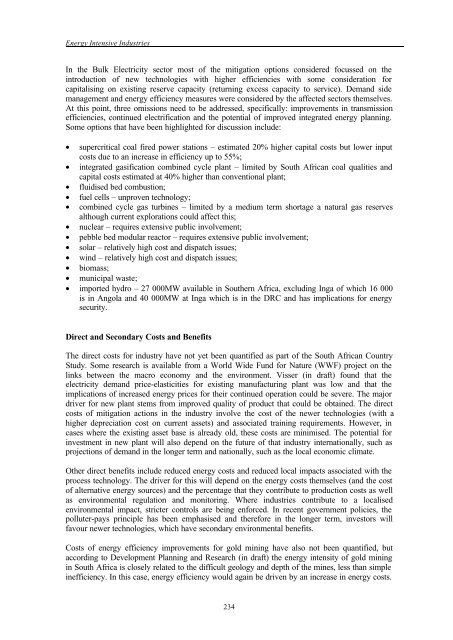sectoral economic costs and benefits of ghg mitigation - IPCC
sectoral economic costs and benefits of ghg mitigation - IPCC
sectoral economic costs and benefits of ghg mitigation - IPCC
Create successful ePaper yourself
Turn your PDF publications into a flip-book with our unique Google optimized e-Paper software.
Energy Intensive Industries<br />
In the Bulk Electricity sector most <strong>of</strong> the <strong>mitigation</strong> options considered focussed on the<br />
introduction <strong>of</strong> new technologies with higher efficiencies with some consideration for<br />
capitalising on existing reserve capacity (returning excess capacity to service). Dem<strong>and</strong> side<br />
management <strong>and</strong> energy efficiency measures were considered by the affected sectors themselves.<br />
At this point, three omissions need to be addressed, specifically: improvements in transmission<br />
efficiencies, continued electrification <strong>and</strong> the potential <strong>of</strong> improved integrated energy planning.<br />
Some options that have been highlighted for discussion include:<br />
• supercritical coal fired power stations – estimated 20% higher capital <strong>costs</strong> but lower input<br />
<strong>costs</strong> due to an increase in efficiency up to 55%;<br />
• integrated gasification combined cycle plant – limited by South African coal qualities <strong>and</strong><br />
capital <strong>costs</strong> estimated at 40% higher than conventional plant;<br />
• fluidised bed combustion;<br />
• fuel cells – unproven technology;<br />
• combined cycle gas turbines – limited by a medium term shortage a natural gas reserves<br />
although current explorations could affect this;<br />
• nuclear – requires extensive public involvement;<br />
• pebble bed modular reactor – requires extensive public involvement;<br />
• solar – relatively high cost <strong>and</strong> dispatch issues;<br />
• wind – relatively high cost <strong>and</strong> dispatch issues;<br />
• biomass;<br />
• municipal waste;<br />
• imported hydro – 27 000MW available in Southern Africa, excluding Inga <strong>of</strong> which 16 000<br />
is in Angola <strong>and</strong> 40 000MW at Inga which is in the DRC <strong>and</strong> has implications for energy<br />
security.<br />
Direct <strong>and</strong> Secondary Costs <strong>and</strong> Benefits<br />
The direct <strong>costs</strong> for industry have not yet been quantified as part <strong>of</strong> the South African Country<br />
Study. Some research is available from a World Wide Fund for Nature (WWF) project on the<br />
links between the macro economy <strong>and</strong> the environment. Visser (in draft) found that the<br />
electricity dem<strong>and</strong> price-elasticities for existing manufacturing plant was low <strong>and</strong> that the<br />
implications <strong>of</strong> increased energy prices for their continued operation could be severe. The major<br />
driver for new plant stems from improved quality <strong>of</strong> product that could be obtained. The direct<br />
<strong>costs</strong> <strong>of</strong> <strong>mitigation</strong> actions in the industry involve the cost <strong>of</strong> the newer technologies (with a<br />
higher depreciation cost on current assets) <strong>and</strong> associated training requirements. However, in<br />
cases where the existing asset base is already old, these <strong>costs</strong> are minimised. The potential for<br />
investment in new plant will also depend on the future <strong>of</strong> that industry internationally, such as<br />
projections <strong>of</strong> dem<strong>and</strong> in the longer term <strong>and</strong> nationally, such as the local <strong>economic</strong> climate.<br />
Other direct <strong>benefits</strong> include reduced energy <strong>costs</strong> <strong>and</strong> reduced local impacts associated with the<br />
process technology. The driver for this will depend on the energy <strong>costs</strong> themselves (<strong>and</strong> the cost<br />
<strong>of</strong> alternative energy sources) <strong>and</strong> the percentage that they contribute to production <strong>costs</strong> as well<br />
as environmental regulation <strong>and</strong> monitoring. Where industries contribute to a localised<br />
environmental impact, stricter controls are being enforced. In recent government policies, the<br />
polluter-pays principle has been emphasised <strong>and</strong> therefore in the longer term, investors will<br />
favour newer technologies, which have secondary environmental <strong>benefits</strong>.<br />
Costs <strong>of</strong> energy efficiency improvements for gold mining have also not been quantified, but<br />
according to Development Planning <strong>and</strong> Research (in draft) the energy intensity <strong>of</strong> gold mining<br />
in South Africa is closely related to the difficult geology <strong>and</strong> depth <strong>of</strong> the mines, less than simple<br />
inefficiency. In this case, energy efficiency would again be driven by an increase in energy <strong>costs</strong>.<br />
234
















